Confessions of a personalization hater
Jan 23, 2020
By Kevin White
Twilio Segment Personas is now part of Segment’s Twilio Engage product offering.
I have a confession to make. I was once a personalization hater.
Don’t get me wrong, it sounded great in theory: content personalized to the user could provide a richer, better user experience. But in practice, it fell short.
For all the hype, all the attempts at personalization I came across were just basic segmentation strategies using static user attributes that were anything but personal.
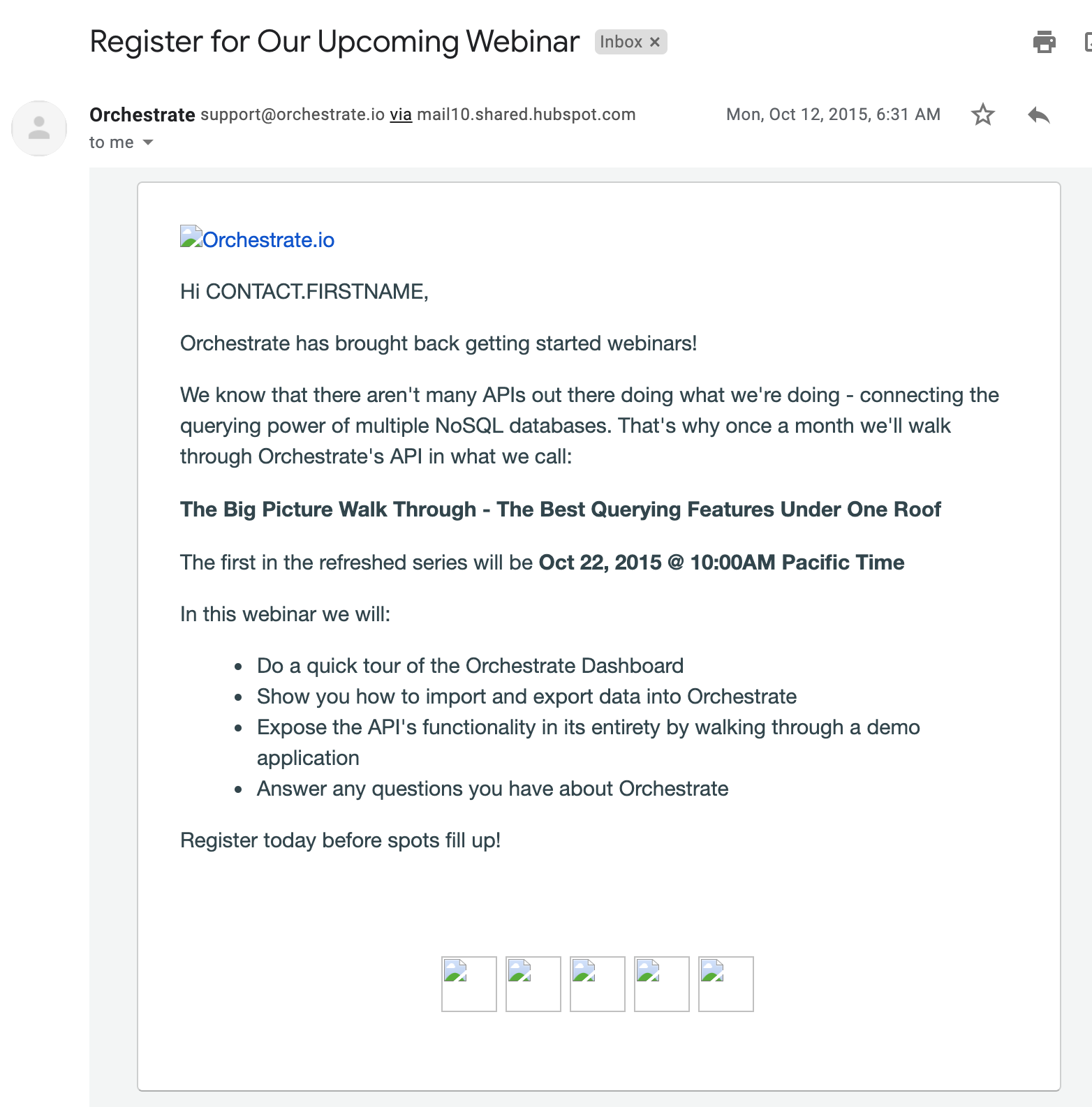
I was pretty happy up on my anti-personalization high horse until I saw Guillaume Cabane, the VP of Growth at Segment at the time, share some genuinely exciting stuff he was doing with data and personalization.
He was using first-party data, cloud sources, and enrichment tools to run marketing campaigns that were a) genuinely tailored to the individual and b) drove actual meaningful business impact.
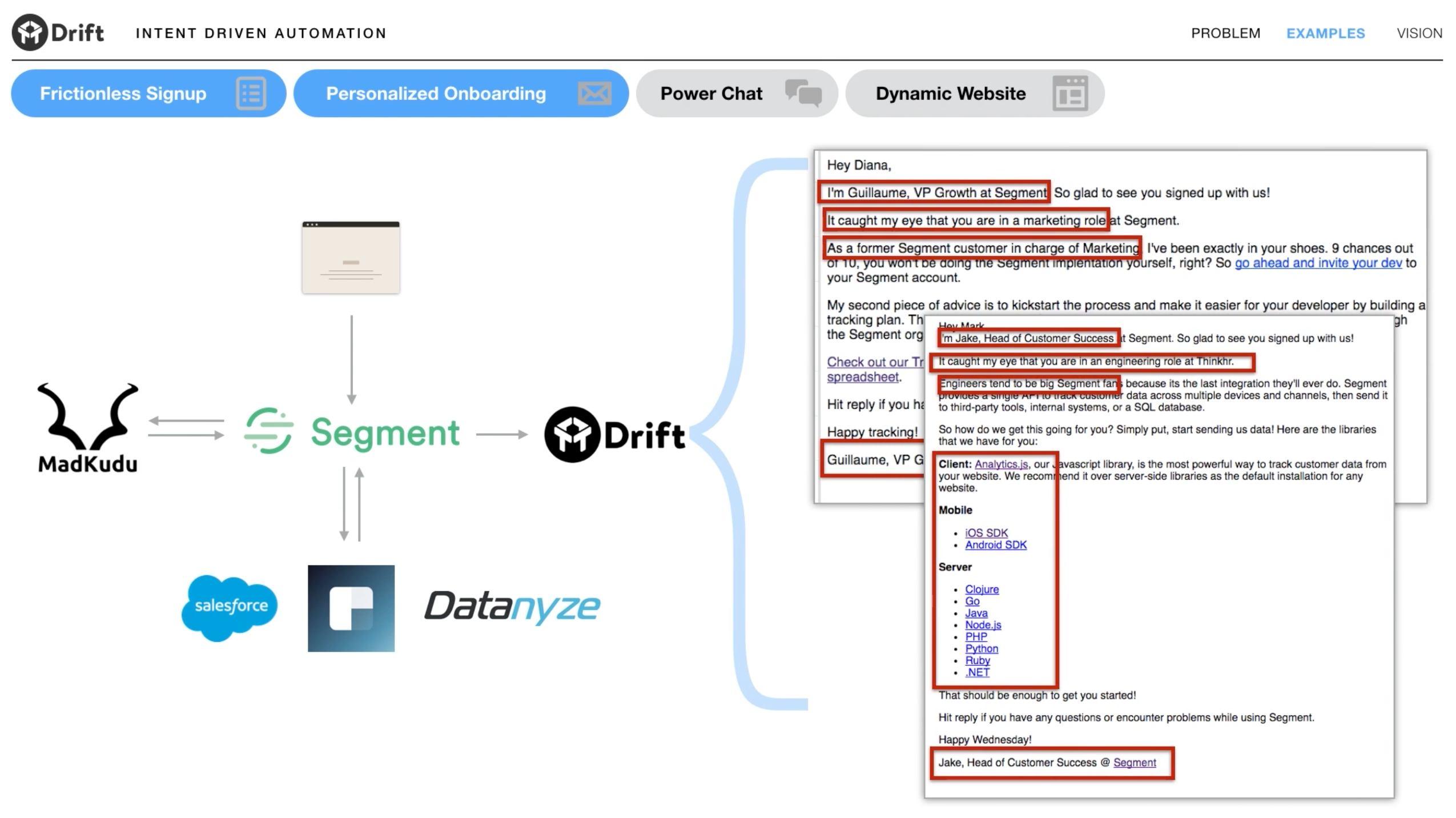
It was a bit of a watershed moment for me. It wasn’t that personalization was all bad. It was just that I hadn’t been exposed to personalization done right.
While up on my anti-personalization high horse, some macro trends were happening in the background.
The first is that we know more about our customers than ever before, due to three major changes over the past decade:
More people are connected. There are now 4 billion global users connected to the internet and growing.
More people are using connected devices. In the US, there are approximately eight networked devices per person.
More data is being generated. 90% of all data had been created in the last two years.
Secondly, there’s been an explosion not just in the quantity of data created, but also in the types of data being collected.
The technology today is way more sophisticated than it used to be. Provided users have opted in and you’re following the correct protocols, it’s now relatively straightforward to know who your users are, what they’re doing on your website, and where those actions are taking place, and have all that data stitched together in one profile.
One of the main issues with personalization over the past few years is the tools we used weren’t equipped to facilitate it. Legacy CRM and email providers couldn’t handle all these new data attributes they were being asked to collect, let alone unify them.
It meant, for the vast majority of marketers, personalization was reduced to inserting a [first_name] tag into an email template. But this isn’t personalization. It’s demographics.
We’ve since seen a transformation from simple JavaScript snippets into robust API calls that will tell you what events users are taking on your website, on your website, on your mobile app, on your web apps, and crucially, who is taking those actions.
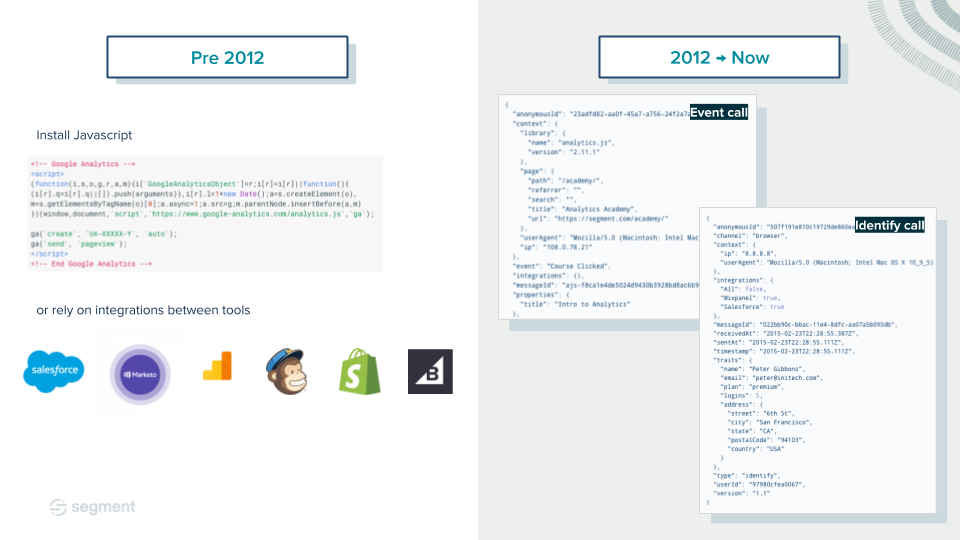
These macro trends have turned me from a personalization skeptic to something of a champion. They led to me testing out different tools and strategies, using our own product Personas. Hopefully, some of what’s below will help others who were personalization skeptics like me.
9 personalization campaigns to try in 2020
Lookalike audiences of your top customers
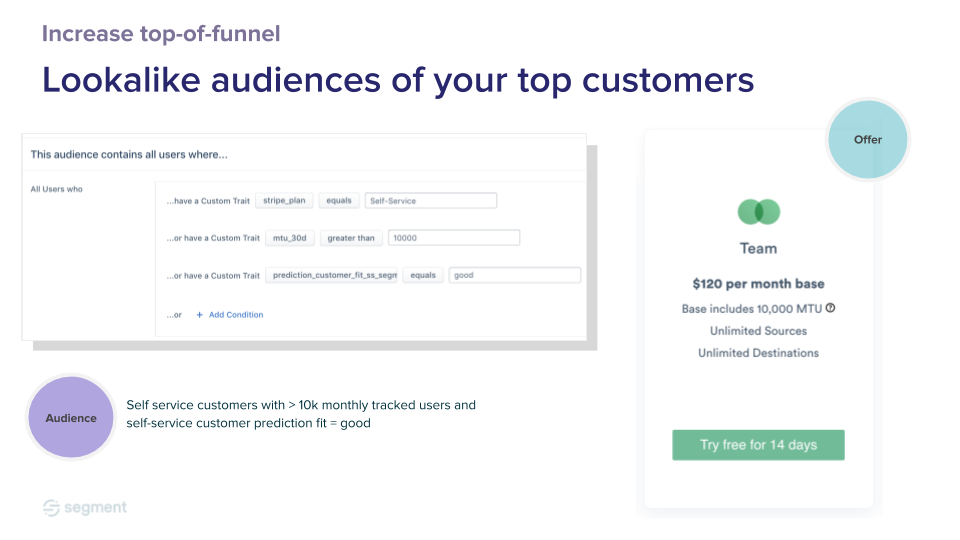
I do a lot of consulting calls with our customers here at Segment, and I recommend the single best place you can start with personalization is to run a campaign targeting similar or lookalike audiences for your best customers.
At Segment, we know our best customers are those from a specific industry and specific company size, with a highly trafficked website.
For this campaign, we use Segment Personas to integrate first-party events and customer data with Facebook, Twitter or LinkedIn Ads. Once there, you can build audiences of your ideal customers, and create lookalike audiences to reach new people who are similar to your best customers. This gives you a high-value audience for you to target with personalized messaging.
Retargeting based on market signals
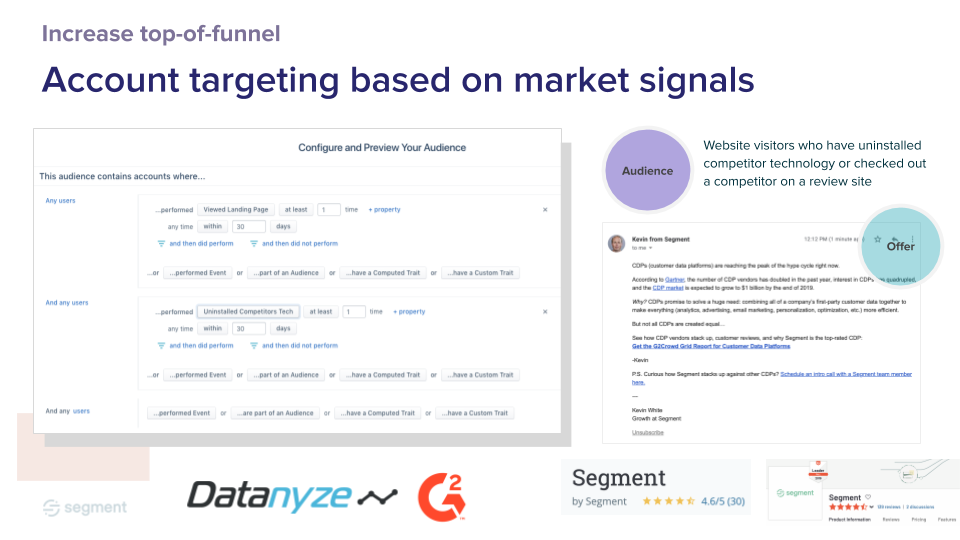
This example is a little bit more advanced. There are a ton of internal and external market signals at our fingertips that can inform intent to purchase – web activity, content consumption, product reviews, switching jobs, etc. These market signals can be found via tools like Datanyze (now Zoominfo), G2Crowd or Crunchbase.
In the example above, we take an audience of anyone who's visited, viewed or engaged with our brand in the last 30 days. Then, we cross-reference this with data from a tool like Datanyze, in this case, prospects who have uninstalled one of our competitors' technology in that same time window.
Combining these data points means we can create a campaign hyper-personalized to the behavior of the recipient, and therefore more likely to be effective.
Bonus: See a recording of exactly how to do this in our webinar (with Guillaume from above) – How to automagically identify high-intent leads →
Personalized experiences for target accounts
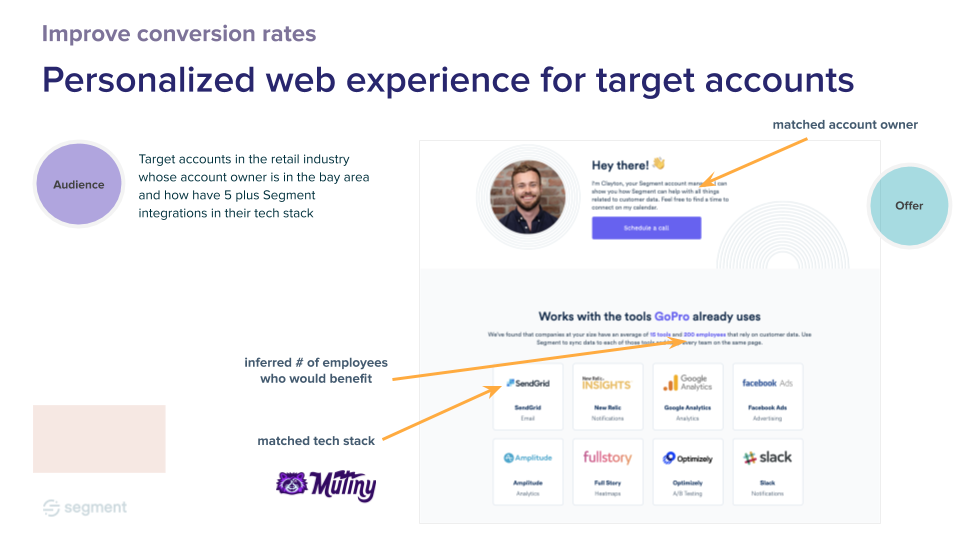
One of my favorite campaigns to run is personalizing experiences for website visitors. To do this, we use a tool called Mutiny.
Mutiny helps you create contextual web experiences for visitors using firmographic, contextual and behavioral data. It then recommends the best segments for personalization by enriching website activity with deals from your CRM and other data sources, allowing you to personalize your website for every visitor without any engineering effort.
This lets your sales and marketing teams do all sorts of fun stuff. For example, an SDR can reach our with an entirely personalized landing page – featuring the number of employees at the company, the tools they’re already using, etc. All of this is based on dynamic information that changes based on who you’re talking to.
Fast track to schedule a meeting after demo request
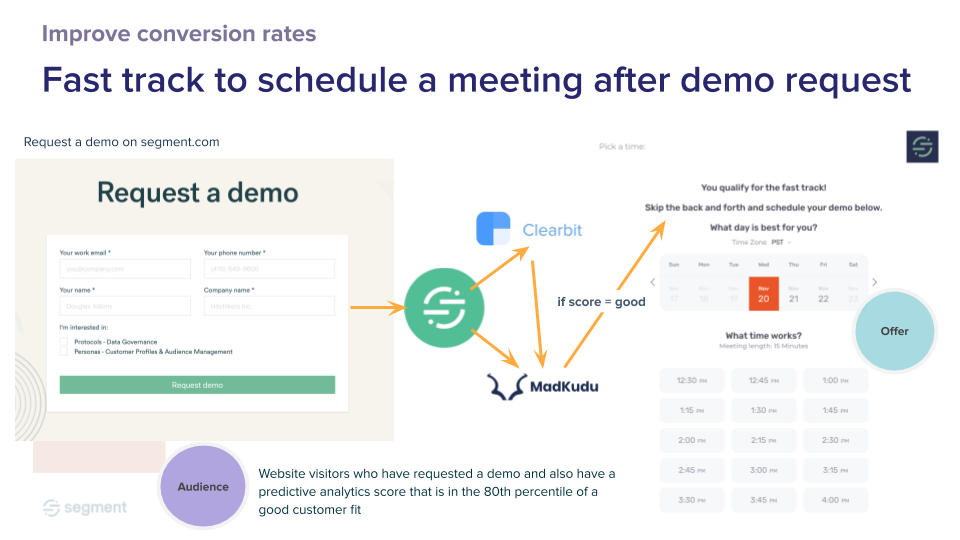
Not all website visitors are created equal. Some are just kicking the tires. Some are in research mode. And some are ready to buy. The challenge is ensuring your messaging caters to the sales-readiness of all these different types of leads.
One thing we’ve found that works particularly well is to open up a “fast lane” for those that have requested a demo. When someone enters their email and company name, we pass them onto our predictive analytics tool, MadKudu, which predicts whether this person is a low fit, a medium fit, a good fit, or a very good fit for our product.
This means we can roll out the red carpet for leads who have a high likelihood of becoming one of our customers. These leads skip all the usual steps and are fast-tracked to book a demo with one of our team members right away.
This type of personalization works really well because it goes much deeper than identity attributes and into sales readiness, greatly increasing your chances of conversion.
Scale positive reviews for your product
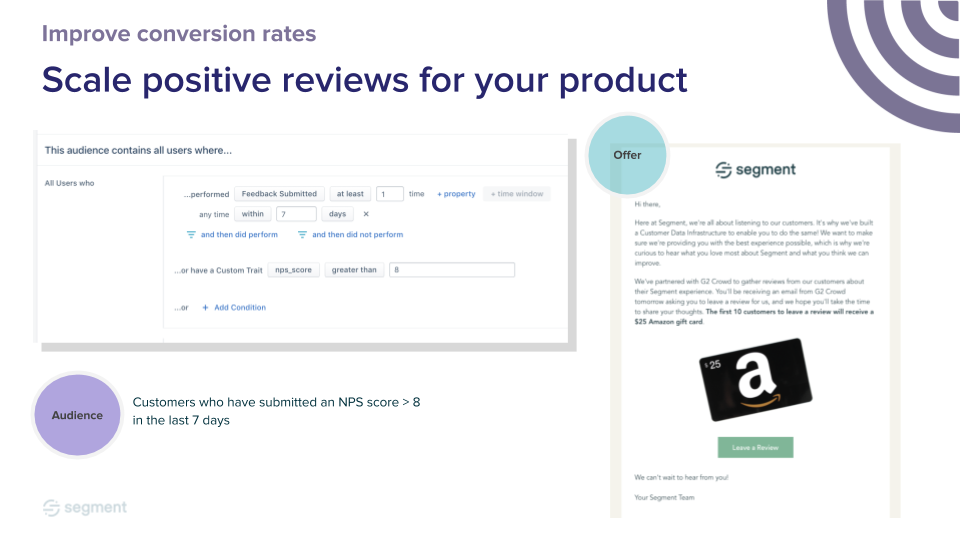
Just five reviews for your product can increase the likelihood of conversion by 4X, so it’s worth spending time generating positive customer reviews for your business.
Doing this manually can be pretty time consuming, but we’ve found a few ways to automate this and make it personal at the same time.
Whenever a customer takes certain actions (like interacting with our support team) they’re asked to fill out an NPS Survey. From this survey, you’ll get a cohort of promoters and detractors.
From there, you can reach out to promoters and ask for a review on a site like G2 or Capterra, and offer a reward upfront.
Automated personalized follow-up emails
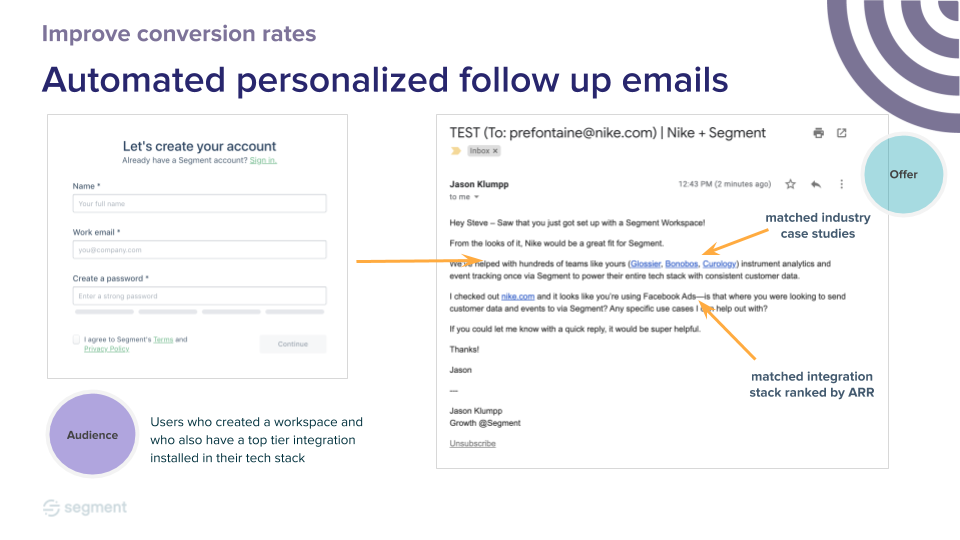
When a user signs up for your product (and opts into communication), it’s a prime window of opportunity to capitalize on their initial interest.
You might think that because they’ve signed up, your job as a marketer is now complete. Far from it. You still need to motivate people through intermediate stages of the buying journey, like consideration and evaluation.
One of the most powerful things you can do is to pull in various first-party data signals about the particular signup (their industry, company size, their existing tech stack, etc.) and send a personalized welcome email based on that intelligence.
For example, let's say a recent signup is an e-commerce company using Facebook ads. Your email copy can recommend relevant case studies, social proof, and use cases that help the prospective user know they are in good company.
Personalized campaigns such as these have been really helpful in getting high response rates, and subsequently activating new signups.
Identify and act on predictive user actions
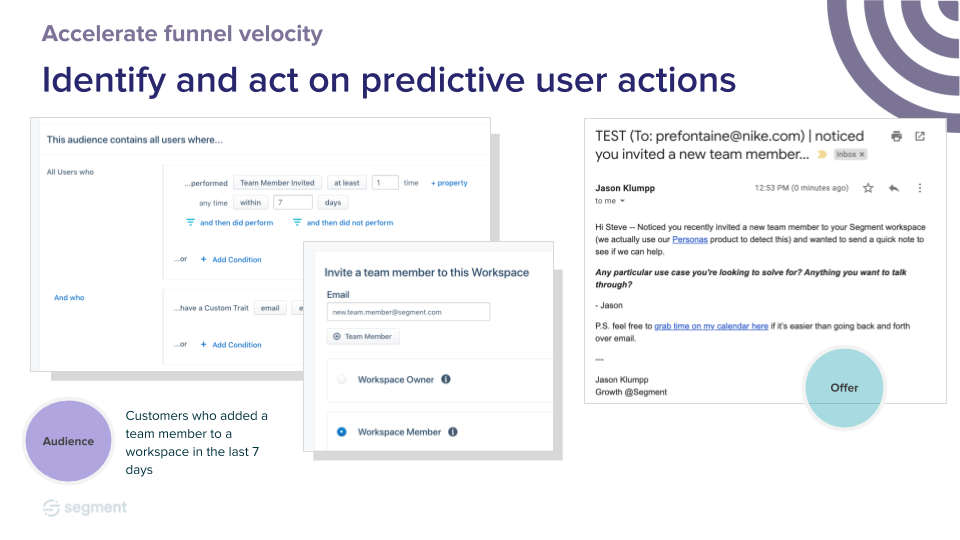
In an ideal world, every visitor to your website would be raising their hand. The reality is that some of your visitors will need a series of nudges and prompts to help them get there.
A good way to do this is to use predictive behaviors to nudge visitors forward through your funnel. Even though people might not be opting-in all the time, you can look at behavioral scores and actions that users are taking and send automated follow-ups to those people based on their actions. For example, are they looking at your integrations page? Are they looking at your documentation page?
A visit to your pricing page is often a good signal of intent. A good campaign to run is to send a triggered email based on specific actions on that page. That could be visitors who are on your pricing page for more than thirty seconds, and/or have visited your pricing page more than three times. The options are virtually endless.
By identifying a very specific audience, and one with high intent, you’ve given yourself a good chance of generating a solid sales opportunity.
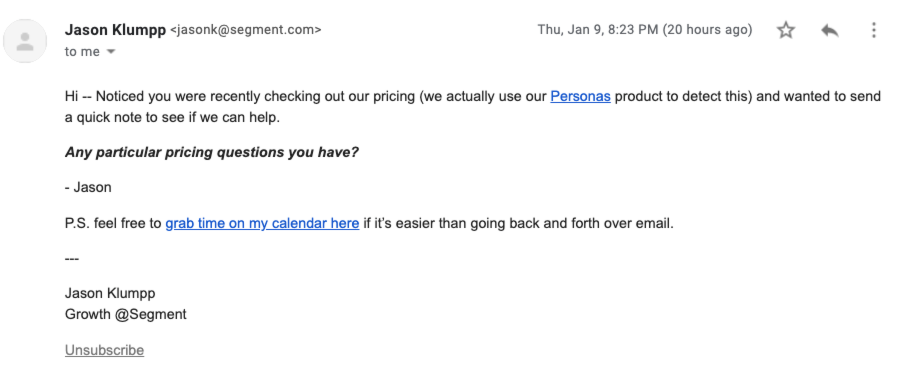
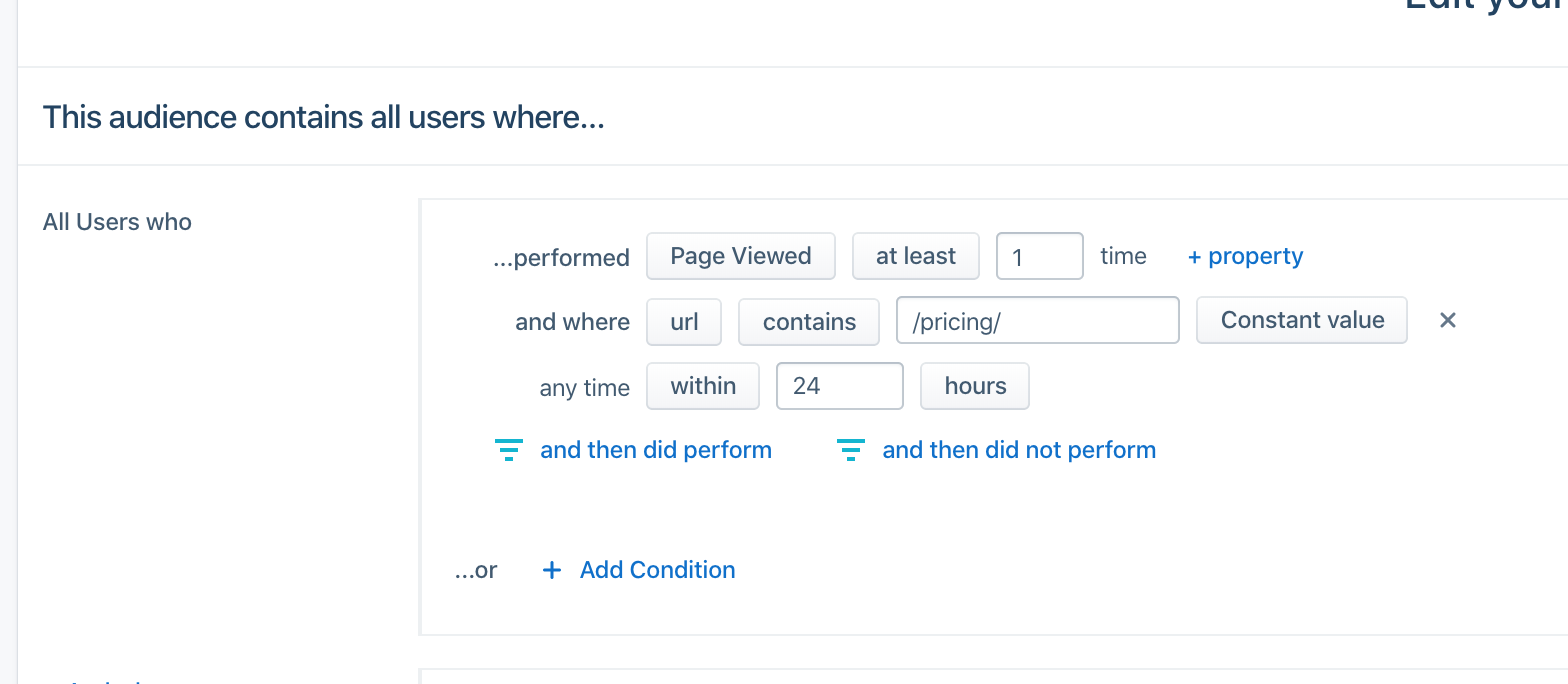
Nudge based on non-activity

In the previous above, we saw that website activity can be a great signal for proactive personalization. But a lack of activity can be an equally important behavioral trigger. In the B2C world, this could mean people who dropped out of the checkout flow or abandoned their carts. In the B2B world, it could be someone who didn’t finish signing up or didn’t take those all-important first few actions in your product.
Regardless of what type of business you have, don’t neglect those users who may be in most need of a nudge back towards engagement.
For example, when we launched the Segment Startup Program, which gives startups $25,000 in Segment credits, we noticed that plenty of people signed up for the program, but that those signups didn’t always translate to usage. By applying personalization and incentivization, we were able to get those people back on track.
“Roll up” email to summarize account activity
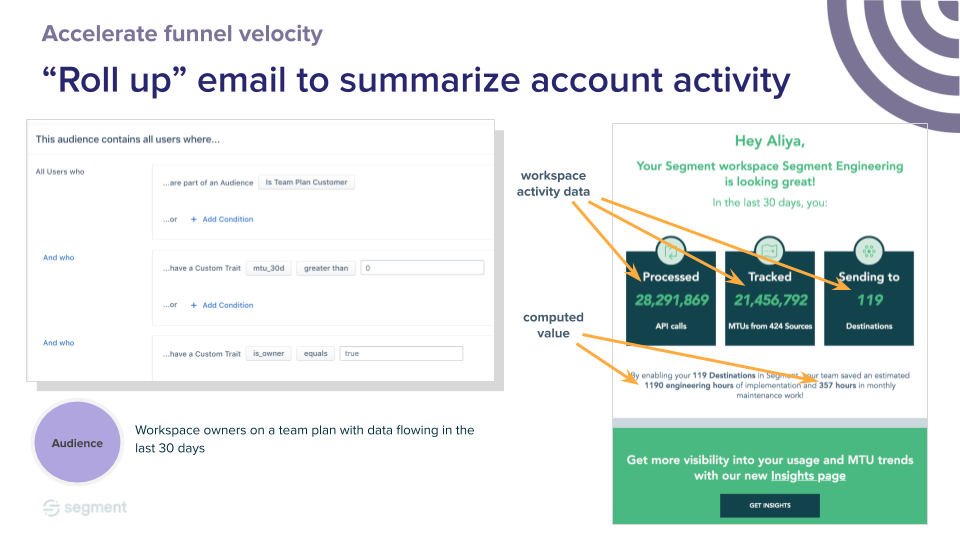
Why is Spotify’s annual “Unwrapped” campaign so successful? Because it’s a pure, unfiltered and, often embarrassing, view of who we are, based entirely on usage. Thankfully, you don’t have to be a billion-dollar music streaming service to take advantage of this deep psychological need.
One of the most powerful personalization emails we send is a summary of a user’s account activity. It taps into existing data about a customer’s past experience over the past month – API calls processed, monthly tracked users, etc.
Emails such as this build on existing momentum by creating a positive feedback loop. Users are more likely to become recurring, valuable customers for your business if they feel they’re making progress with your product.
The one secret to getting personalization right...
Regardless of which of the above strategies you decide to try out, the secret is this – you must add value with personalization. You have to offer something the user wants, not just decorative garnishes like adding their company name. Trust me when I say that nobody is going to buy a product just because you added their company name to an email. If it doesn't l help them impact their bottom line or achieve their goals, they won’t be interested.
If you’d like help getting any of these personalization campaigns up and running with Segment, see if you qualify for our fast-track demo, or just drop me an email –k.white@segment.com.
The State of Personalization 2023
Our annual look at how attitudes, preferences, and experiences with personalization have evolved over the past year.
Get the report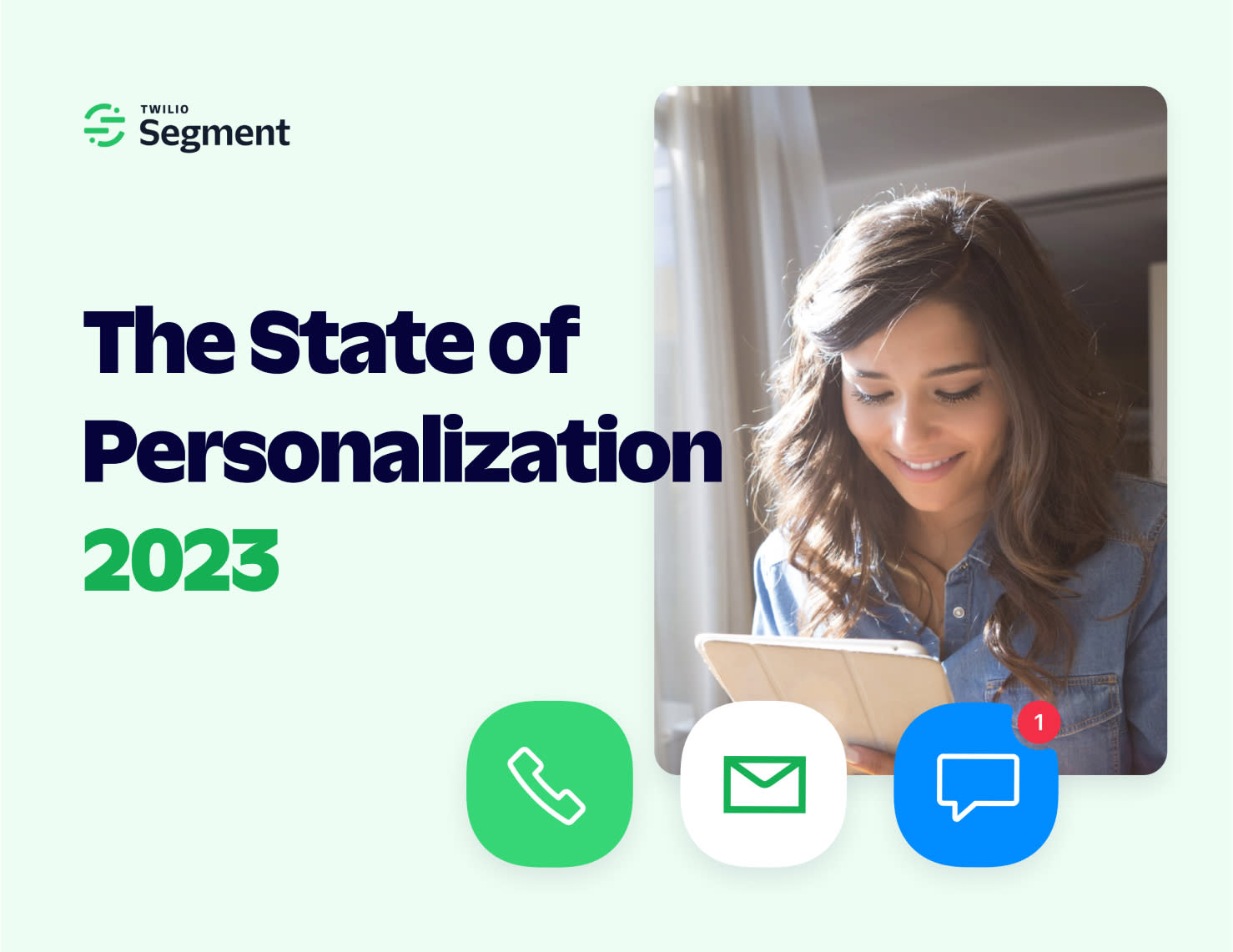
The State of Personalization 2023
Our annual look at how attitudes, preferences, and experiences with personalization have evolved over the past year.
Get the report
Share article
Recommended articles
How to accelerate time-to-value with a personalized customer onboarding campaign
To help businesses reach time-to-value faster, this blog explores how tools like Twilio Segment can be used to customize onboarding to activate users immediately, optimize engagement with real-time audiences, and utilize NPS for deeper customer insights.
Introducing Segment Community: A central hub to connect, learn, share and innovate
Dive into Segment's vibrant customer community, where you can connect with peers, gain exclusive insights, and elevate your success with expert guidance and resources!
Using ClickHouse to count unique users at scale
By implementing semantic sharding and optimizing filtering and grouping with ClickHouse, we transformed query times from minutes to seconds, ensuring efficient handling of high-volume journeys in production while paving the way for future enhancements.